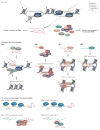The rise of regulatory RNA
- PMID: 24776770
- PMCID: PMC4314111
- DOI: 10.1038/nrg3722
The rise of regulatory RNA
Abstract
Discoveries over the past decade portend a paradigm shift in molecular biology. Evidence suggests that RNA is not only functional as a messenger between DNA and protein but also involved in the regulation of genome organization and gene expression, which is increasingly elaborate in complex organisms. Regulatory RNA seems to operate at many levels; in particular, it plays an important part in the epigenetic processes that control differentiation and development. These discoveries suggest a central role for RNA in human evolution and ontogeny. Here, we review the emergence of the previously unsuspected world of regulatory RNA from a historical perspective.
Conflict of interest statement
The authors declare no conflict of interest.
Figures



References
-
- Gilbert W. Origin of life: The RNA world. Nature. 1986;319:618.
-
- Comfort NC. The Tangled Field: Barbara McClintock’s Search for the Patterns of Genetic Control. Harvard University Press; Cambridge, Massachussetts: 2003.
-
- Watson JD, Crick FH. Molecular structure of nucleic acids; a structure for deoxyribose nucleic acid. Nature. 1953;171:737–8. - PubMed
Publication types
MeSH terms
Substances
Grants and funding
LinkOut - more resources
Full Text Sources
Other Literature Sources
Miscellaneous

